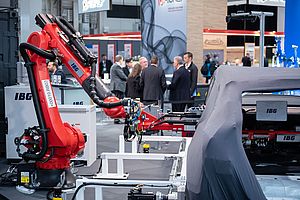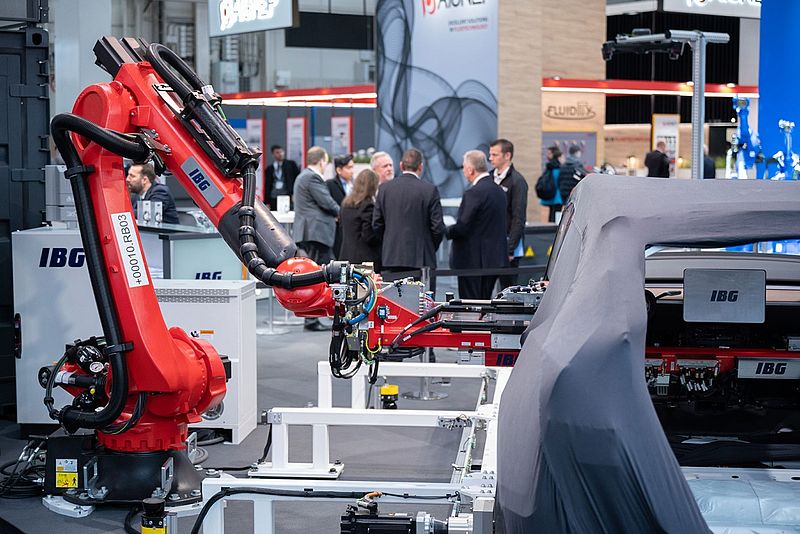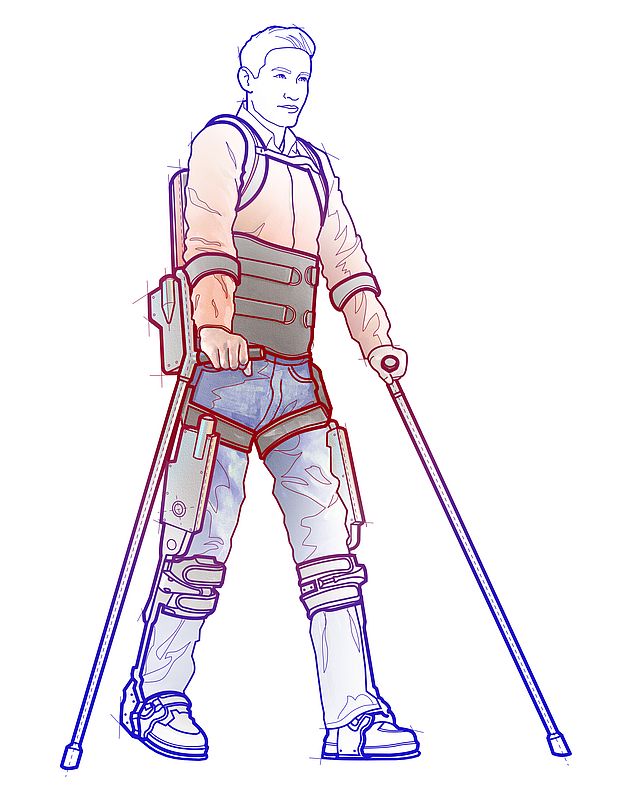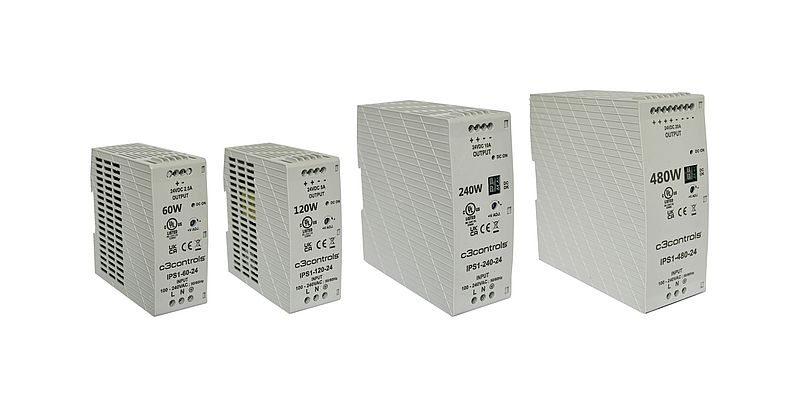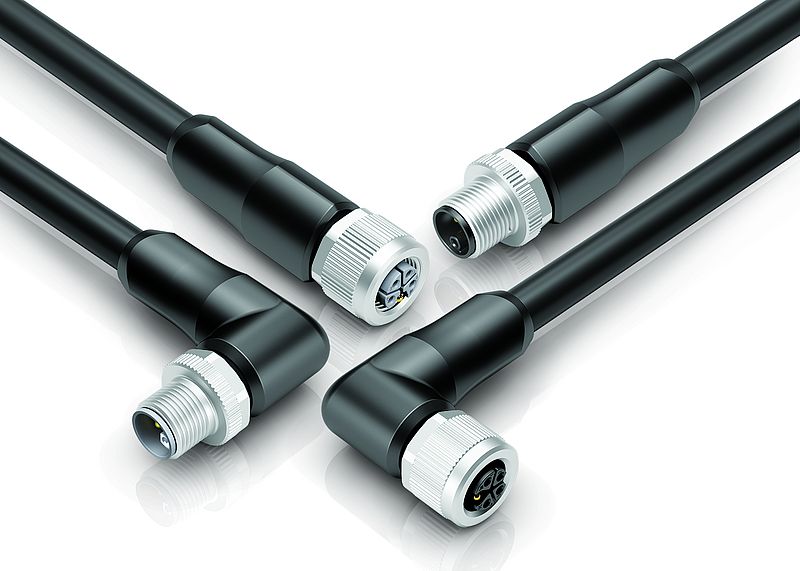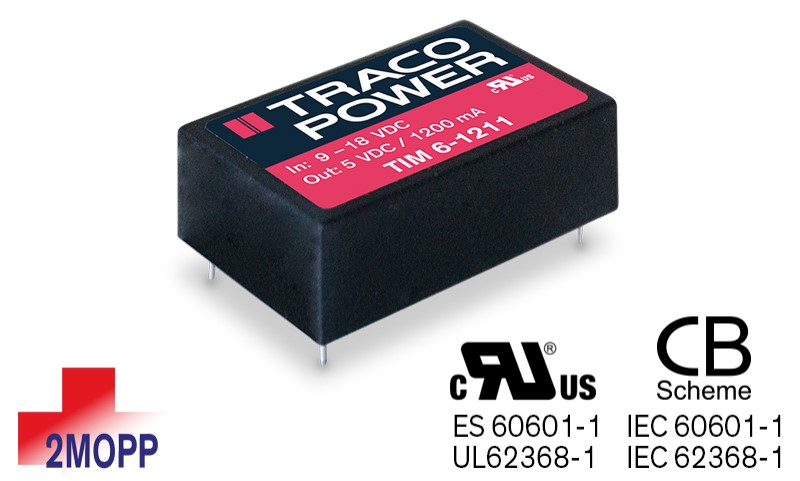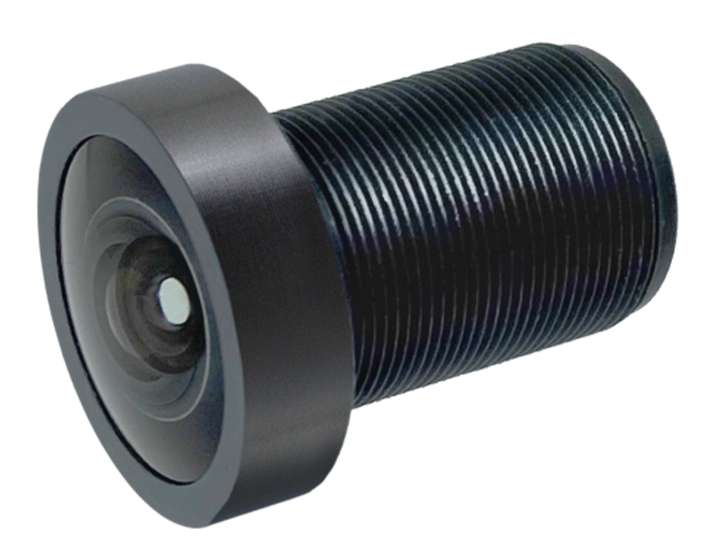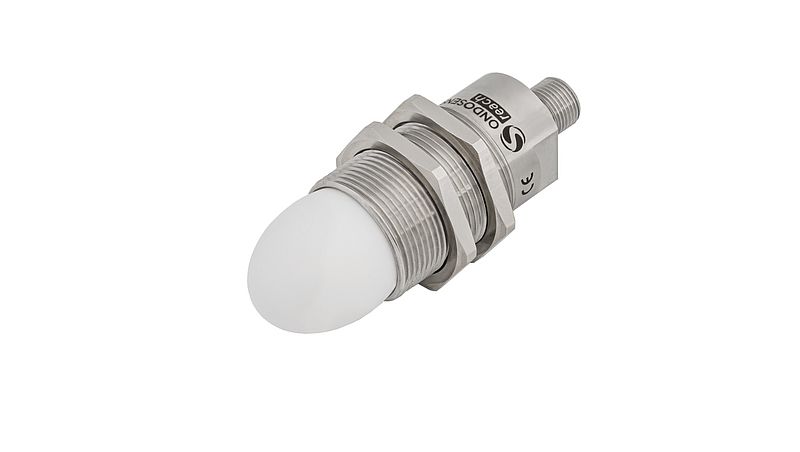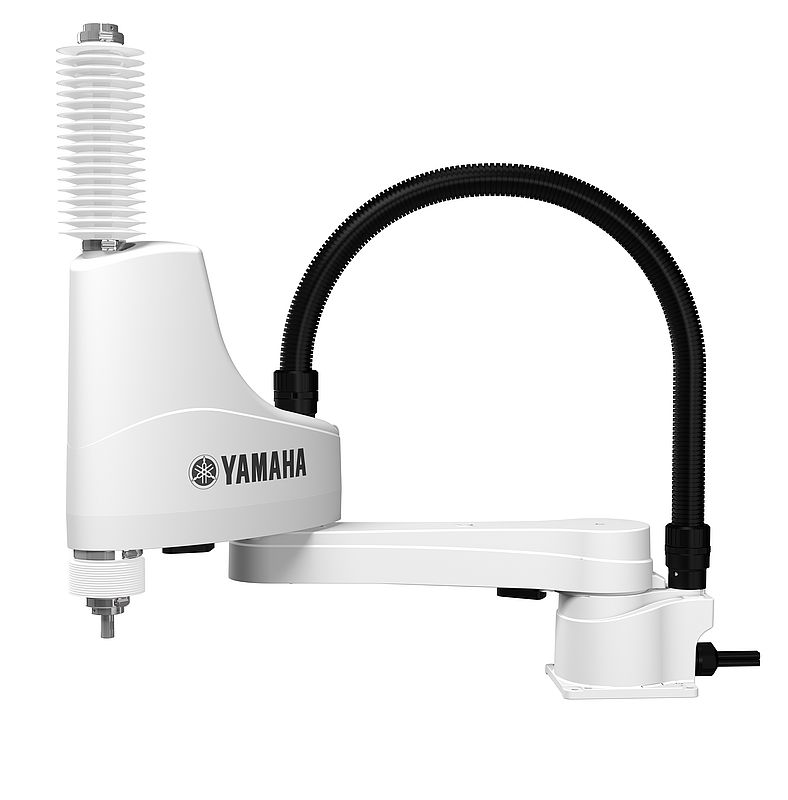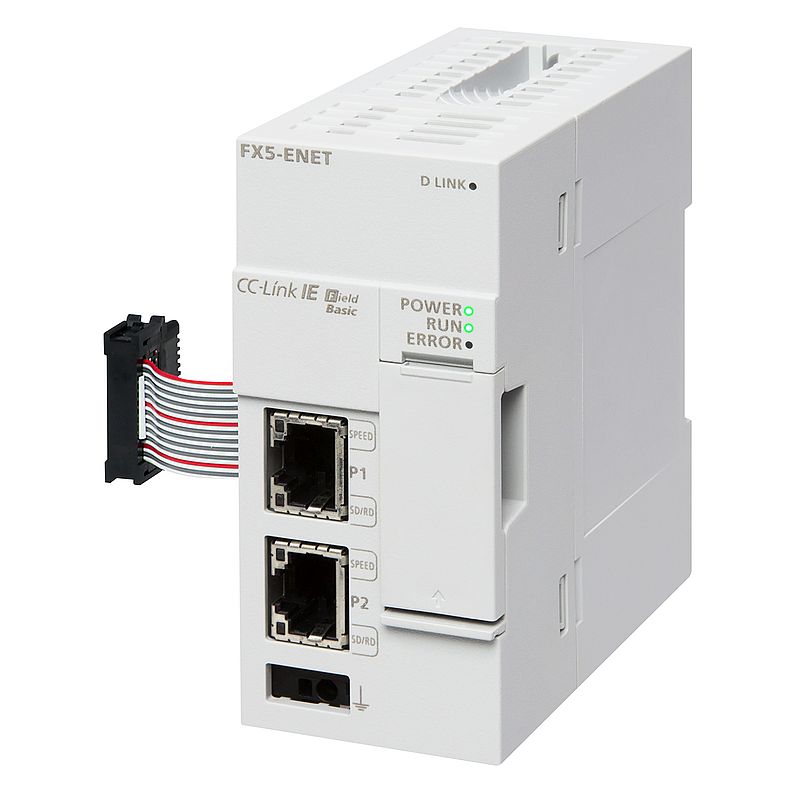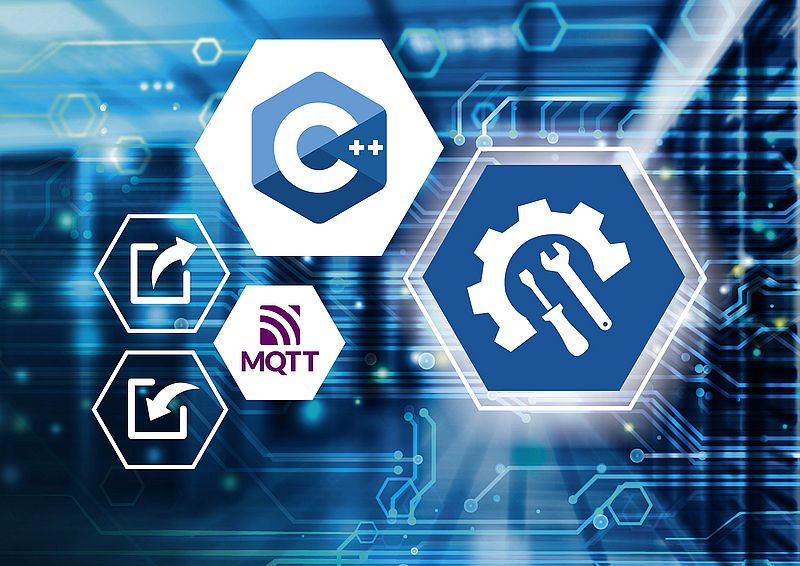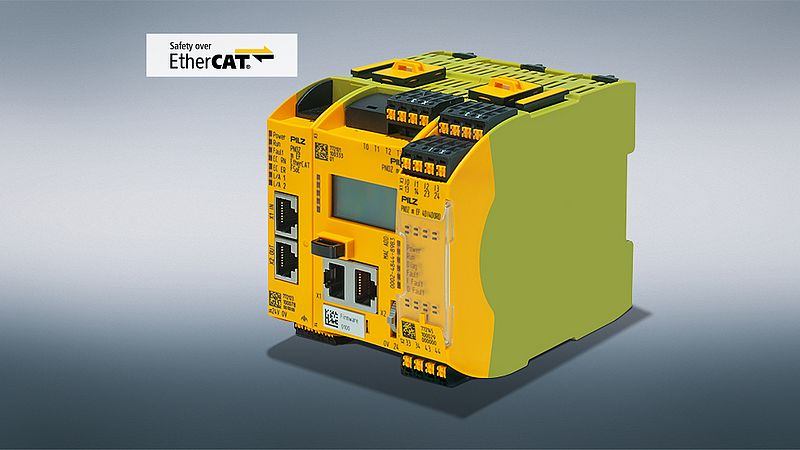Quick access
Industry News I3 Industry News II4 Industry News III5 Shows and Events6 Upgraded Servo Drive System with Enhanced Security7 Motors & Drives: Nanotec | Bosch Rexroth8 Electronics & Electricity I: C3controls | binder9 Electronics & Electricity II: Toshiba Electronics | Traco Power10 Vision & Optical Measurement: Resolve Optics | InfraTec11 Automation I: LIKA | OndoSense12 Automation II: Yamaha | Unitronics13 Automation III: Mitsubishi Electric | Softing14 Automation IV: Fluke Process Instruments | PILZ15 Index16 Contacts17Companies in this issue
Fluke Process Instruments GmbH15 Lika Electronic Srl12 Resolve Optics Ltd11 Traco Electronic AG10 Unitronics13 Yamaha Motor Europe N.V.13Bosch Rexroth AG8 C3controls9 Fluke Process Instruments GmbH15 Franz Binder GmbH & Co. elektrische Bauelemente KG9 InfraTec GmbH Infrarotsensorik und Messtechnik11 Lika Electronic Srl12 Mitsubishi Electric Europe B.V14 Nanotec Electronic GmbH & Co. KG8 OndoSense GmbH12 Pilz GmbH & Co. KG15 Resolve Optics Ltd11 Siemens AG7 Softing Industrial Automation GmbH14 Toshiba Electronics Europe GmbH10
#2
#3 Industry News I
#4 Industry News II
#5 Industry News III
#6 Shows and Events
#7 Upgraded Servo Drive System with Enhanced Security
#8 Motors & Drives: Nanotec | Bosch Rexroth
#9 Electronics & Electricity I: C3controls | binder
#10 Electronics & Electricity II: Toshiba Electronics | Traco Power
#11 Vision & Optical Measurement: Resolve Optics | InfraTec
#12 Automation I: LIKA | OndoSense
#13 Automation II: Yamaha | Unitronics
#14 Automation III: Mitsubishi Electric | Softing
#15 Automation IV: Fluke Process Instruments | PILZ
#16 Index
#17 Contacts
Security in the field of operative technology (OT) is proving itself to be a decisive requirement for secure data collection, which is of crucial importance when it comes to implementing digitalization projects and optimizing production processes. At the same time, normative requirements on the cyber security of machines, systems and companies are becoming stricter. PI (PROFIBUS & PROFINET International) already realized some time ago that the underlying requirements in OT security are of utmost importance. Step-by-step specifications, proofs of concept and guidelines were developed by technical working groups. This process makes it possible to adapt the scope in a manageable and flexible way.
Important steps towards implementation
PROFINET Security Class 1 has now transitioned to concrete implementation. For this purpose, PI established infrastructure for the signing of GSDs (General Station Description files, a description of an IO device including configuration, parameters and diagnostical information). The basic elements for Security Classes 2 and 3 have been defined in the most recent specifications and include a definition of crypto-algorithms and certificate handling, among other things. This means that hardware and firmware producers have already been able to get started with development. At present, the final functions –some of which have also been derived from IEC62443 – are being specified in detail, including security reporting.
As expected by both members and users alike, PI is establishing certification alongside this. The result will be applicable and recognized security technology which meets the respective requirements and has been developed in close cooperation with manufacturers, users and relevant institutions and authorities. With this concrete progress, PI is making a valuable contribution to the strengthening of cyber security in the OT field and is also helping to make the digital transformation in industry more secure.
New CEO at the Endress+Hauser Group
Dr Peter Selders takes over as CEO from Matthias Altendorf, who is the new president of the supervisory Board
Endress+Hauser has completed the announced change at the top of the Group: The 54-year-old Dr Peter Selders has taken over the CEO position at the Swiss specialist for measurement technology and automation solutions. He holds a doctorate in physics, has been with the company since 2004 and was previously managing director of the competence center for level and pressure measurement technology based in Maulburg, Germany. He is only the fourth CEO in the Group’s 70-year history.
His predecessor Matthias Altendorf (56) is moving to the Supervisory Board after 10 years at the helm. In 2014, he became the first non-family CEO to succeed Dr Klaus Endress. He is now replacing the 75-year-old as president of the Supervisory Board. In future, two members of the third generation will represent the interests of the shareholder family: In addition to Sandra Genge, Steven Endress, a grandson of the company founder, joined the board on 1 January 2024.
Peter Selders has been succeeded at Endress+Hauser Level+Pressure by Dr Dirk Mörmann (50), who was previously head of technology and a member of the management board. Endress+Hauser had already announced all these changes to the public in February 2023.
PI USA Awards Contract for new Production Facility in Shrewsbury, Massachusetts
New plant will massively expand manufacturing capabilities for the american market
PI USA signed a contract to build a new 119,575 square foot facility in Shrewsbury, Massachusetts. This is three times the size of the current US sites in Auburn, MA, Hopkinton, MA and Nashua, NH combined. Starting in 2025, PI will use the new facility to manufacture components and system solutions for motion, precision positioning and piezo applications for the North American market, as well as to drive the development of innovative technologies and products.
“Over the past five years, the annual turnover of PI USA has grown by more than 10 percent. At the same time, production in the USA could be increased by 30 to 50 percent each year,” says Markus Spanner, CEO of the PI Group. “With this new production facility, we lay the foundation based on which we will be able to meet the sturdy growth of the American markets and to manufacture an increasing proportion of our products directly locally. This will enable us to meet customer requests more flexibly and quickly.”
Expanding local production and innovations
With core competencies in nanopositioning, piezo technology and performance automation, PI has become an established supplier to companies in the industrial automation, photonics, semiconductor, microscopy and life sciences markets. Markus Spanner is convinced that only the CHIPS and Science Act, which aims to create incentives for semiconductor production, and the Inflation Reduction Act, which actively promotes the establishment of companies in the USA, will lead to sustainable growth in these markets.
After completion of the new facility in Shrewsbury, production will continue at the current sites for a transitional period. Ultimately, the new facility will offer the opportunity to manufacture additional products such as piezo motors and tip/tilt systems for the photonics market segment. At the same time, the new building will expand the company's development capacity for innovative system solutions in the USA. The new facility is part of the largest investment programme in the Group's history. The PI Group is currently investing more than sixty-three million euros in expanding its production capacity worldwide.
New Leadership in Yokogawa's Regional Headquarter
Seita Hagihara Takes Over as President of Yokogawa Europe
Yokogawa Europe B.V. announces that Seita Hagihara has been appointed as the new president of the Yokogawa regional headquarters for Europe as of January 1. Hagihara succeeds Takayuki Matsubara, who will be moving into the role of CEO in Yokogawa Group company KBC.
After studying Economics & Geography at the University College of London, Hagihara began his career as a sales engineer at Yokogawa Electric Corporation in Tokyo, Japan. He can look back on 26 years of experience in various roles at Yokogawa, ranging from sales to finance and global major account management.
International experience
In 2021, Hagihara was appointed vice president of System Sales & Sales Operation at Yokogawa Corporation of America. Based in Texas, his responsibilities included leading system sales, business development, proposals, and sales operations from Canada to Central America, as well as supervisory management of Yokogawa Mexico. In addition, he led the regional Energy & Sustainability business.
With effect from January 1, 2024, Seita Hagihara will be in overall charge of managing Yokogawa’s operations in Europe from the Yokogawa Europe headquarters in The Netherlands.
“I am incredibly excited to return to Europe after almost a decade and truly honored to be the new President of Yokogawa in Europe where I will be devoting all my energies to working with customers to help them achieve their sustainability and business goals. Over the last two years, the European region has continued to experience its fair share of challenges. These include the climate crisis and high domestic energy costs affecting the daily lives of all Europeans and also industry.
At Yokogawa, we strive to contribute with solutions, in line with Yokogawa’s Purpose, a statement that reads, ‘Utilizing our ability to measure and connect, we fulfill our responsibilities for the future of our planet.’
My goal is to support Yokogawa’s growth as the leading company in decarbonization and energy efficiency, boosting the competitiveness of European manufacturing,” states Seita Hagihara.
Dr Michael Berger Appointed to the IDS Management Board
The new year brings change in the management of the machine vision specialist from Neckarsulm/Germany
Dr Michael Berger has been appointed Managing Director of IDS Imaging Development Systems GmbH with effect from 1 January. After 27 years at the helm, Jürgen Hartmann, founder and shareholder of the industrial camera manufacturer, is stepping down. The generational change at the Obersulm-based machine vision specialist has been successfully completed with the appointment of 42-year-old Berger to the IDS management team. In future, Berger will be responsible for sales, marketing, product management and system consulting. Jan Hartmann, son of the founder, will now be responsible for Finance, Human Resources, IT and Business Innovation & Ecosystem, while Alexander Lewinsky will take over Development in addition to his previous responsibilities in Operations. Jürgen Hartmann is handing over the management of the operational business and will advise the family business in the areas of technology and innovation as Chief Innovation Manager. He will remain managing partner of Hartmann Holding GmbH.
Dr Michael Berger studied business administration at the University of Bayreuth and obtained his doctorate in sales and market management at the University of Constance. He was most recently General Manager of Li-Ion Cells at VARTA AG. A clear market orientation always characterises his actions. "The product portfolio of IDS has an enormous market potential that needs to be exploited to the full," says Michael Berger, who is looking forward to his new role.
It was important for Jürgen Hartmann to prepare early and carefully for the handover of management responsibility in his own company. With the promotion of his son Jan to the Management Board and the appointment of Alexander Lewinsky in 2021, he initiated this step four years ago. "Continuity and reliability are particularly important to us in relation to our partners and customers. Everything has its time, and after more than 40 years of working life, it's time for me to take another step back," says Jürgen Hartmann, explaining his decision. The 61-year-old industry pioneer, who is regarded as the father of the USB interface for industrial cameras, will continue to "support where desired and help where necessary" in the company founded by him, as he says. His main focus will continue to be on the development area.
ADI Appoints New Executive Vice President and CFO
Analog Devices announced that Richard C. Puccio, Jr. will join the company on February 5, 2024 as Executive Vice President and Chief Financial Officer.
In his new role, Mr. Puccio will set ADI’s financial strategy and lead the company’s global finance operations. Mr. Puccio will report to CEO and Chair Vincent Roche.
“Rich brings tremendous experience and capability from his more than three decades of leading financial advisory and high-growth business operations activities in complex technology sectors, and this makes him a great addition to ADI’s leadership team. We welcome Rich’s sharp business acumen to enable ADI to accelerate the effectiveness of our operations in a world of increasing opportunity and complexity,” said Vincent Roche, ADI’s CEO and Chair. “I would also like to thank Jim Mollica for his partnership and contribution as interim CFO, and I look forward to Jim’s continued leadership in ADI’s finance organization,” continued Mr. Roche.
Mr. Puccio joins ADI from Amazon Web Services (AWS), a leading global cloud and technology services provider, where he served as CFO. In his role at AWS, Mr. Puccio partnered closely with the business to manage more than 200 fully featured services, including compute, storage, databases, robotics, machine learning and artificial intelligence (AI), Internet of Things (IoT), mobile, and security, among many other technologies. Prior to his role at AWS, Mr. Puccio was at PricewaterhouseCoopers (PwC) for nearly 29 years, where he served as a partner for over two decades. During his tenure at PwC, Mr. Puccio primarily served clients in the global technology, semiconductor, and semiconductor capital equipment industries.
“With its innovative spirit, amazing talent, and dedication to enriching lives and the world around us, ADI has exceptionally strong growth potential. I’m delighted to be joining ADI as the company’s new CFO and look forward to bringing my digital, software, and platform experience to the company as we play an increasingly important role in creating the Intelligent Edge and driving new levels of shareholder value,” said Mr. Puccio.
Mr. Puccio earned his BA in Economics from Harvard University and his MBA from Boston University.
Application Park Robotics at HANNOVER MESSE from 22. to 26 April
Close cooperation between HANNOVER MESSE and the German Robotics Association brings application examples to life
Robotics is a key theme at HANNOVER MESSE. Robots of all shapes and sizes - from industrial robots and cobots to autonomous mobile robots - are on display throughout the exhibition grounds. A special highlight this year is the Application Park in Hall 5, which has a strong partner in the German Robotics Association (DRV). The DRV's mission is to promote and support the use of robotics in Germany. There is undoubtedly potential in this area, given the shortage of skilled workers in Germany, which ranks fifth in the world behind China, Japan, Korea and the US.
"With the robotics experts from DRV, we have partners at our side with whom we will further build on the topic of robotics, in conjunction with that of automation, at HANNOVER MESSE. There is no better place in the world to showcase the diverse examples of robotic applications," says Hubertus von Monschaw, Global Director HANNOVER MESSE at Deutsche Messe AG.
Engage with new technologies
Young robotics companies and start-ups in particular will be demonstrating the wide range of applications for robots and the interaction between humans, machines and artificial intelligence in the Application Park. Visitors will be able to see and try out robotic automation for themselves. One of the highlights will be driverless transport systems, which will demonstrate how many activities will no longer require a driver in the future.
"This exhibition platform offers visitors to HANNOVER MESSE a unique opportunity to engage with new technologies and learn how robotics, AI and automation can help solve the enormous challenges facing industry," enthuses Helmut Schmid, CEO of the DRV.
Portescap Will Showcase Micro-Motion Solutions at R-24 in Odense
At the R-24 tradeshow for robotics, drones and automation in Odense from March 13 to 15 the company will exhibit their solution portfolio for demanding robotic applications, including bionics and exoskeletons, inspection and surveillance robots, end-of-arm grippers, and surgical robotics.
The Portescap portfolio presented at R-24 in Odense is designed to meet the demanding requirements of modern robotics, with miniature brushed DC, brushless DC and stepper motors designed for high efficiency, low power consumption and maximum power density in a wide range of environmental conditions. These solutions provide an optimal balance of torque and speed, improving overall performance and reducing cycle time. Portescap's customisation capabilities are also noteworthy, with options such as temperature probes for thermal management, special materials, connectors, custom coil designs, shaft lengths and mechanical integration choices.
Fellow Regal Rexnord brand Kollmorgen will be co-exhibiting with Portescap at R-24. This joint exhibit underscores the strong partnership and synergies between our brands and demonstrates the strong portfolio in Hall A at booth 1705 from March 13 to 15.
Servo Drive System Equipped With New Hard- and Software
New hardware architecture with functional enhancements like a second encoder interface for an even larger range of applications
Motors & Drives
Siemens is innovating the well-established Sinamics S210 servo drive system with a new hardware architecture and new V6 software generation that expand the system's range of applications. The servo drive system is especially suitable for applications with high dynamics in the power range between 50 W and 7 kW: for example, machines for packaging, pick & place applications, and digital printing.
To make it even easier to control individual axes in the future, the new generation of the Sinamics S210 comes with a second encoder interface and offers the option to connect a direct measuring system to compensate for mechanical looseness and tolerances. This significantly increases precision, which makes more applications possible.
New security functions
With its Basic and Extended Safety Integrated functions, the new Sinamics S210 ensures the comprehensive implementation of the safety concept in the machine and meets the requirements of SIL3 (EN 61508) and PL e (EN ISO 13849-1). Another new feature of the system is the Security Integrated functions that ensure greater safety in industrial systems with user management and access protection.
Robust in aggressive production environments
In addition to Profinet IRT, the Sinamics S210 now offers communication via EtherNet/IP. This means that third-party controllers can also be connected to the servo system, which significantly increases the range of applications, especially in the U.S. market. With the new 3C3 (H₂S and SO₂) coating, the new generation is extremely robust and can resist aggressive environmental influences like sulfur gases. This means that the servo system also guarantees high system availability and productivity under difficult production conditions: for example, in the tire industry.
The EPOS single positioner is now also available as a technology function for the Sinamics S210. With this function module, high-precision motion control positioning tasks can be implemented quickly and easily in the converter because positioning tasks can be calculated directly in the drive. This reduces computing power in the controller, which can instead calculate more complex tasks or a larger number of drive axes.
Simulating motion control
The new generation also enables the simulation of motion control applications. Using the DriveSim Advanced simulation software, a digital twin of the Sinamics S210 can now also be created in the TIA Portal. This can be used to virtually commission the drive system in advance and perform engineering tasks. Requirements for the processes in the drive train can therefore be ensured cost-effectively and efficiently. In addition, the digital twin offers the opportunity to create virtual training courses and demonstrations and to optimize real machines by eliminating problems in the drive train, which are simulated with the digital twin.
Nanotec presents the PD1-C, a stepper motor with integrated controller and encoder. In a 28 mm flange size (NEMA 11), this compact smart servo achieves a maximum holding torque of 18 Ncm and a peak current of 3 A. Three motor versions are available: one with protection class IP20, a version with IP65 and a motor with open housing that can be modified for applications with customer-specific connectors.
Single-turn encoder
A CANopen and a Modbus RTU interface facilitate parameterisation, and Nanotec's free Plug & Drive Studio software ensures user-friendly programming. The PD1-C's single-turn absolute encoder further enhances performance through closed-loop control. The compact design of this stepper motor makes it ideal for applications where space is at a premium, effectively reducing both wiring complexity and installation costs.
High-Quality Ball Rail System for Standard Tasks
Flexible combination of rails and runner blocks can be replaced individually
Motors & Drives
With the BSCL (Ball Rail System Compact Line), Bosch Rexroth has expanded its portfolio, adding a versatile, high-quality linear guide. The new product family for applications with lower performance requirements complements the BSHP high-precision range. The economical guides are particularly suitable for use in assembly and handling tasks as well as for woodworking systems or in machine tools. With six sizes from 15 to 45, six runner block designs, three pre-load classes and the three accuracy classes N, H and P, the new BSCL product family covers a broad range of applications. The C100dyn load capacity is up to 79,200 N, while the maximum speed is 5 m/s. The new BSCL ball rail systems close the gap between high-precision ball rail systems and simpler guide rail systems such as linear bushings or cam roller guides.
Digital engineering, quick delivery and installation
Like all linear guides from Bosch Rexroth, the BSCL ball rail system can be selected, configured and ordered online quickly and easily using modern e-tools. The global Rexroth network ensures quick delivery and maximum availability. The profiled rail systems in the new range are available in lengths of up to four meters in one piece and can easily be shortened to the desired length using simple tools. After cutting to length, the ends only need to be deburred – there is no need for time-consuming chamfering. In addition, precision rails and runner blocks of the same size can be combined with each other as required. This makes logistics easier and reduces the work involved if servicing is required.
Long service life reduces maintenance costs
The sealing concept of the runner blocks prevents chips and other contaminants from infiltrating the runner blocks, thus helping to ensure a long service life. The runner blocks are supplied with initial lubrication and can be relubricated from both end caps. The design with eight lubrication points gives users greater freedom. Front seals, scraper plates and front lube units are available as accessories.
Industrial Low Voltage Power Supplies
For equipment that requires control within electrical panels and enclosures
Electronics & Electricity
c3controls has launched a new line of Industrial Power Supplies that provide stable, low voltage power for equipment that requires control within electrical panels and enclosures. The new Series IPS power supplies deliver up to 93% efficiency, the best in its class among comparable devices, and are available in output power ranges from 60W to 480W and voltage options in 12, 24 and 48V. Ideal for regulating power loads in residential, commercial and industrial applications such as HVAC, manufacturing, industrial automation, and pump and motor control, the c3 power supplies are UL listed, CE marked, and RoHS compliant.
The ultra-compact Series IPS power supplies range in width from 43 to 60mm, and are designed to fit in panels of almost any size, with quick and simple snap-on installation on a 35mm DIN Rail. The control devices provide reliable protection against short circuit, overload, overvoltage and over-temperature occurrences, and feature an auto-recovery function. The output voltage of the devices is flexibly adjustable from 100 to 116%. The LED indication allows users to see the availability of the DC power output to assist in troubleshooting. The power supplies from 240W to 480W come with DC OK Relay Contacts to provide status signals to the monitoring system.
Overmolded M12 Cable Connectors
Developed according to the UL 2238 standard
Electronics & Electricity
binder is expanding its M12 portfolio by adding K- and L-coded overmolded cable connectors of the 823 and 824 series, which were developed according to UL 2238. These are primarily intended for use in the power supply of field devices in automation technology. The connectors provide a compact alternative to power connections using 7/8-inch technology.
The K-coding indicates 5-pin connectors for AC supply of e.g., drives or frequency converters. Target applications of the likewise 5-pin connectors with L-coding include DC miniature drives, decentralized I/O modules, and other automation components that are supplied with DC voltage in field bus systems.
The K-coded products of the binder 824 series with screw locking are characterized by their ampacity of up to 12 A per pin under continuous load at rated voltages of 630 V(AC) respectively. The L-coded products in the 823 series have a rated current of 16 A and a rated voltage of 63 V (DC). Gold-plated contacts guarantee reliable current transmission. The fully overmolded connectors ensure protection of the interface according to IP68and have an operating temperature range from: -40 °C to +90 °C
Ready for the markets of North America
The rapid and seamless introduction of new products to the markets of different world regions is an increasingly important competitive demand. Export to North America, for example, requires conformity to US safety regulations. This in turn can be proven by certification from a qualified and recognized test laboratory. With the UL approval from Underwriters Laboratories, manufacturers of electromechanical connectivity products can prove that their components meet the safety requirements for North America. Interfaces designed for rated currents up to 16 A and rated voltages up to 630 V require approval according to UL 2238. UL 2238 certification is currently in preparation.
Robust, flexible, reliable
The K- and L-coded overmolded M12 cable connectors were developed in conformance with IEC 61076-2-11 for use in industrial-automation environments. Thus, product designers and installers are provided with a robust and variably applicable interface technology that ensures reliable power transmission to AC and DC field components even at high ambient temperatures. The IP68-compliant interfaces feature a protected seal within the M12 socket, and the M12x1 thread is equipped with an anti-vibration lock. Furthermore, connection cross-sections up to 2.5 mm2 are available.
Photorelay With Inbuilt Protection Features
For greater reliability in electrically noisy environments
Electronics & Electricity
Toshiba Electronics Europe has just released the first >1.4A-rated DIP4 package photorelay that has an OFF-state output terminal voltage of 80V, over temperature and over voltage protection functions. Photorelays integrate the functions of a photocoupler with an output MOSFET switch and are often used to replace mechanical relays. As solid-state devices there is no contact wear, they are silent in operation, small in size and require very little power to operate.
Alternative to mechanical relays
These devices are used in a wide variety of applications including building management, sensors, I/O interfaces, battery management systems and anywhere a mechanical relay can be used. Toshiba’s new TLP241BP photorelay is configured as 1-Form-A / normally open (NO) and is capable of a continuous on-state current (ION) of 1.4A and 4.2A (IONP) for pulsed operation. It offers an input-output isolation voltage (BVs) of 5,000 Vrms and is capable of operating at ambient temperatures between -40 °C and +110 °C.
For operation in electrically harsh environments
Inbuilt over temperature protection function inhibits the output MOSFET to protect against over current situations. Also, an active clamping MOSFET protects the device when an overvoltage exceeding the blocking voltage rating is applied. The inclusion of these protection functions makes the device suitable for use in environments with high levels of electrical noise such as industrial applications or air conditioning systems.
With comprehensive inbuilt protection and solid-state operation, the TLP241BP significantly contributes to the reliability of equipment in electrically harsh environments.
The TIM 6 series from Traco Power is a cost efficient range of medical 6 Watt DC/DC converters in DIP-24 plastic package with wide 2:1 input voltage range. They provide a reinforced isolation system for 5000 VAC and a very low leakage current of less than 2 μA.
The units are approved to IEC/EN/ES 60601-1 3rd ed. for 2 x MOPP and come along with an ISO 14971 risk management file. Design and production conform to the quality management system ISO 13485. With a high efficiency of up to 89% and highest grade components the converters can reliably operate in an ambient temperature range of –40°C up to +95°C and up to a n altitude of 5.000m. They constitute a reliable solution not only for medical equipment but also for demanding ranges of application such as transportation, control & measurement or IGBT drivers.
Compact Lens for Operating in High Radiation Areas
Non-browning lens for small sensor cameras
Vision & Identification
The Model 390 from Resolve Optics is a new compact non browning lens for small sensor cameras operating in high radiation areas. Designed to provide high performance imaging up to a total radiation dose of 100,000,000 rad, this new 5mm fixed focus non-browning lens is optimized for use with ¼-inch image format radiation resistant CCD cameras. Providing true HD quality images, the Model 390 lens sets a new standard for high-quality imaging of high radiation nuclear applications including monitoring of hot cells, belt lines and close inspection of baffle bolts.
Resolve Optics’ model 390 produces clear, sharp images free of a strong yellow tint has traditionally been a limitation of radiation resistant lenses on colour cameras. The development drew upon the manufacturers in-depth knowledge of radiation resistant optical materials to help solve this problem. The fixed focus, radiation resistant lens enables ¼-inch format CCD cameras to capture clear, high-definition colour images, with minimum geometric distortion from 400 to 770nm.
SWIR Infrared Cameras for High Temperatures
High-resolution, radiometrically calibrated for temperatures from 300 to 1700 °C
Test & Measurement, Vision & Identification
Specially designed for thermographic measurement tasks involving very high temperatures and challenging materials are SWIR infrared cameras ImageIR® 8100 and ImageIR® 9100. Both thermography systems operate in the shortwave infrared (SWIR) range and extend InfraTec's thermographic temperature measurement portfolio. In high-temperature applications between 300 °C and 1,700 °C, for example, they enable emissivity-optimised temperature measurements on metallic surfaces. Other applications include additive manufacturing and laser applications, welding processes and press hardening in the metal industry.
Different resolutions – radiometrically calibrated
The cameras do not require a mechanical cooler. This makes them suitable for maintenance-free continuous operation. With the new InfraTec SWIR cameras, users have at their disposal thermographic cameras that are equipped with a high degree of measurement accuracy as well as very good short and long-term stability.
Compact, robust and easy to integrate
The modern interface concept makes it easy to control the camera and to acquire data in full frame format up to 237 Hz. Combined with the control and analysis software of the IRBIS® 3 family, the new SWIR infrared cameras from InfraTec are a versatile tool for numerous monitoring and measuring tasks.
With their compact design and low weight, the ImageIR® 8100 and ImageIR® 9100 SWIR infrared cameras are ideal for integration into existing system environments. The ImageIR® 8100 and ImageIR® 9100 are extremely rugged and perform well in harsh environments. With the included Software Development Kit (SDK), all camera features are easily accessible.
Unlocking New Opportunities for Encoders with CC-Link Certification
To address market demands and deliver value-adding products to its customers, Lika Electronic chose to develop new encoders compatible with network technologies from the CC-Link Partner Association (CLPA).
Sensor Technology
Lika Electronic’s Ethernet encoders family grows and adds the CC-Link IE Field Basic compatibility to its EXM58 magnetic and EXO58 optical series. CC-Link IE Field Basic is the popular, 100 Mbit version of the CC-Link IE open industrial Ethernet. It is an ultra-high speed and ultra large capacity network, which provides both synchronous deterministic (cyclic) communication and asynchronous on-demand messaging (transient) communication. Originated with the CC-Link (Control & Communication) fieldbus in 1996 developed by Mitsubishi Electric Corporation, it is managed by the CC-Link Partner Association (CLPA) currently. CC-Link is among the most popular Ethernet-based networks in the world. It is a de facto standard in Asia, but the USA and the United Kingdom are using CC-Link increasingly.
Wide range of temperature
The EXM58 and EXO58 absolute rotary encoders are CC-Link certified and belong to Lika’s wide Ethernet family which also includes Profinet, EtherNet/IP, EtherCAT, POWERLINK, and MODBUS/TCP devices. The EXM58 encoders mount the robust magnetic sensing technology while the EXO58 encoders are equipped with the high accuracy optical sensing technology. They are very light and compact thanks to the integration of the Energy Harvesting Technology circuit. It enables the multiturn counter to be battery-free and gearless and the risk of mechanical failures to be significantly reduced at the same time. The range of the working temperature is extended from -40°C to +100°C (-40°F to +212°F) to cover many industrial applications. They can mount solid and blind hollow shafts. Also the Universal power supply circuit is very useful, it enables an input voltage of +5Vdc +30Vdc. Singleturn versions provide resolutions up to 18 bits while multiturn versions offer resolutions up to 30 bits. They have axial connector outlet.
Small Radar Sensor Suitable for Confined Spaces
Highly accurate and fast, with wide measuring range
Sensor Technology
OndoSense presents the new OndoSense reach radar sensor for distance measurement, object detection and positioning. With its great performance and reliability, it is ideally tailored to the market needs of industrial automation. The sensor combines millimeter accuracy and high measuring speed with a wide measuring range. And as one of the smallest distance sensors on the radar market, it is also suitable for confined spaces and short measuring distances. Thanks to innovative radar technology, the OndoSense reach measures reliably – even in challenging production environments with dirt, smoke, steam, rain, poor light conditions or rough surfaces. The OndoSense reach is thus perfectly suited for the automation of outdoor applications in agriculture, mining, transport and logistics as well as for factory automation in the manufacturing industry.
High performance even for demanding applications
With its practical M30 housing design and a length of only 92 millimeters, the sensor is one of the smallest radar sensors for distance measurements, object detection and positioning. The OndoSense reach also offers a measurement accuracy of ± 2 mm and a measuring rate of 100 Hertz. As a result, the distance radar is also suitable for demanding applications. The measuring range of the sensor starts at 0.2 meters and reaches up to 40 meters. With an RS485 communication protocol, an analog current interface (4-20 mA) and three digital switching outputs (PNP/NPN), customers benefit from powerful industrial interfaces for data transmission to the programmable logic controller (PLC).
Thanks to its dust-proof, jet water-proof housing (IP 67) and its resistant PTFE lens, the robust distance radar is also suitable for demanding production environments and outdoor applications. The high-performance radar sensor is ideal for distance or dimension measurement, object positioning or detection in agriculture, mining, transport and logistics, shipping and offshore, mechanical and plant engineering or in the energy sector.
Yamaha Robotics’ Factory Automation Section is adding the new clean type YK-XEC series to its YK-XE series. It offers SCARA robots with high operational and cost performance. The YK-XEC series meets ISO Class 4 (ISO 14644-1) cleanliness standards, which are in high demand in the current market.
For food and medical applications
The main specifications such as the arm length and Z-axis stroke, as well as maximum payload are identical to the YK-XE series. By achieving a high operational performance of 0.42sec (YK510XEC) for a standard cycle time, this new model will further contribute to improving productivity as well as realizing labor savings in manufacturing plants for semiconductors and hard disk drives, which has seen growing demand recently, as well as in the food and medical equipment-related plants.
Io-Link Solution to Enable Seamless Communication Between Sensor, Actuator and Controller
Flexible and easy device management for efficiency in critical automation processes
Automation, Sensor Technology
Unitronics has launched its IO-Link solution to enhance the automation experience of its customers. This new product offering encompasses IO-Link, which has been standardized by the International Electrotechnical Commission (IEC). IO-Link is a fieldbus communication solution for sensors, actuators, and mechatronics that can be integrated into any existing fieldbus, information technology, or automation system. Thanks to the popularity of IO-Link, users can pick and choose which components they want for their applications.
Unitronics’ IO-Link solution, which does not require any coding, makes it easy for machine builders to effortlessly streamline their operations. It only takes one click to connect Unitronics' IO-Link with other components in the automation ecosystem. This automated setup process solves the issue of manual configurations and related problems. It is designed to keep things easy and simple since all controllers support IO-Link via the Ethernet/IP communication protocol. The programming consists of two easy steps - after dragging and dropping the configuration, all that needs to be done is assigning IP addresses. Once done, all communications are completely transparent and seamless.
Easy integration and setup
Also, the IO-Link solution of Unitronics is not just a standalone feature but a vital part of Unitronics' end-to-end approach to automation. The added value of IO-Link is its capability to provide any application with easy setup, a simple architecture, and straightforward diagnostics. Combined with UniLogic, Unitronics’ drag & drop all-in-one software for developing PLC and HMI apps in one environment, implementing the IO-Link bi-directional data transfer is quick and easy thanks to its drag & drop configuration. This makes it the ideal option to avoid issues such as intricate wiring and cumbersome setup processes.
Unitronics has always been at the forefront of integrating intelligence into automation, and IO-Link is a testament to that commitment. This new offering enhances the Unitronics product family, bringing additional benefits to the all-in-one offering by unifying intelligence across the system. Machine builders now have access to a single, comprehensive platform that integrates IO-Link effortlessly, which ensures the seamless operation of all connected components, including controllers, sensors, and actuators.
Compact Ethernet Module with Extended Connectivity
Upgraded Hardware adds cloud connectivity and extended security features to PLC-Series
Automation
Mitsubishi Electric has updated its FX5-ENET Ethernet unit to offer advanced Industrial Internet of Things (IIoT) capabilities within machines using MELSEC iQ-F series PLCs. End users and machine builders can now drive operational efficiency even further by leveraging expanded access to cloud computing, cybersecurity and email functions that support enhanced connectivity and data management.
Thanks to a hardware update to the FX5-ENET Ethernet module for iQ-F series PLCs, it is now possible to collect data in the Cloud, in line with IIoT principles. As a result, machines using this unit can benefit from data-driven analytics to support predictive maintenance strategies, simplify troubleshooting and improving productivity. Even more, a Cloud-based solution can help to drive profitability.
Smart and secure operation
The Cloud connectivity function is supported by MQTT, a communications protocol that is optimised for IIoT devices and can maximise accessibility and enable the realisation of a wide range of applications. Ultimately, it is possible to benefit from advanced connectivity that support remote access. In addition to this, the use of MQTT within the FX5-ENET Ethernet unit assists users in setting up seamlessly interconnected machines for smart operations while protecting their factories from cybersecurity threats. The protocol also includes key security features, such as encryption and digital certifications, that help to prevent, detect, respond to and address potential risks through retransmission if a message is not received, TLS encryption and client authentication.
Finally, encrypted email sending functions are built into the latest FX5-ENET Ethernet solution, with free email services, such as Gmail and Yahoo mail, supported. This means that operators can receive notifications via a secure SMTP server, improving availability, accessability and responsiveness.
OPC UA Software Development Kit
With OPC UA Pub/Sub via MQTT for targeted, resource-saving data transmission
Automation
Softing Industrial has expanded the functionalities of its OPC UA C++ SDK (Software Development Kit) with the new version 6.30. Data transmission using OPC UA Pub/Sub (Publisher/Subscriber) via MQTT (Message Queuing Telemetry Transport) is now possible in addition to the previously available UDAP protocol (Universal Data Augmenting Processor). The new implementation supports both the widely used MQTT version 3.x and the new version 5.0.
Data security is guaranteed by encrypting the communication using SSL (Secure Sockets Layer). Easy data evaluation at the application level is possible because OPC UA JSON coding (Java Script Object Notation) serves as the transmission format.
Data transmission with Pub/Sub via MQTT offers many benefits to users. These include:
- Scalability: Pub/Sub via MQTT can be easily scaled to a large number of devices or subscribers without compromising performance.
- Efficiency: The protocol overhead with MQTT is low, which makes data transmission efficient and resource-saving.
- Reliability: MQTT provides mechanisms for Quality of Service (QoS), which make it possible to control message delivery and ensure that messages are delivered reliably depending on the requirements of the use case.
- Flexibility: Thanks to the clear separation of publishers and subscribers, MQTT enables flexible and dynamic communication between different devices and applications, which is particularly suitable for distributed systems or the IoT.
The development kit is available for Windows, Linux, and VxWorks. It offers developers, system integrators, and device and control manufacturers an easy and fast way to integrate OPC UA into their automation and Industry 4.0 applications. A comprehensive collection of libraries with a concise, clearly documented programming interface as well as corresponding sample applications, and test and simulation tools are included in the software package and enable a fast time to market. All SDKs have the OPC UA Testlab certification. Users can therefore be sure that they are choosing the safest and fastest way to compliant, robust, and high-performing OPC UA products. A demo version with full functionality and a limited runtime as well as detailed release notes and technical data sheets are available for download on the Softing Industrial website.
Thermal Imager with GigE-Interface
Options for standalone operation and PC-based analysis
Vision & Identification
Fluke Process Instruments extends its ThermoView TV30 series, launching a GigE thermographic camera in addition to the spearhead standalone version. The infrared cameras for fixed installation enable 24/7 thermal monitoring of processes and assets. They identify temperature anomalies and send alerts, allowing plant staff to rectify any problems early on and avoid poor quality output and damage to products and equipment.
Automated monitoring
The standalone version with onboard analytics and remote setup via web browser needs no PC in the field to automatically monitor up to 32 values for user-specified Areas of Interest (AOI) and criteria (max./min., average, spot temperature, standard deviation).
Manual and automated image archiving
The GigE version was designed to meet the most sophisticated requirements. It enables direct communication between programmers and the camera using standard applications like Labview or Matlab or the proprietary ThermoView software. It connects to a shop-floor or control-room PC and can stream thermal images at up to 60 frames per second. The ThermoView software provides an extensive array of features and functions for all typical industrial temperature monitoring and documentation needs. It supports an unlimited number of AOI, trending for those AOI and manual or automated archiving of images as well as measured values for traceability.
The thermal imagers can detect temperatures from -10 °C to 1300 °C (14 °F to 2372 °F). For improved accuracy, users can specify tighter temperature ranges. The imagers feature a rugged, IP67-rated housing. The series also provides a choice of two infrared camera resolution options, three lenses for different fields of view and protective accessories for demanding environments. All versions boast excellent connectivity, with multiple supported protocols for easy integration in plant-level automation systems and computerized maintenance management systems (CMMS).
Configurable Small Safety-Controller
Integrated FailSafe over EtherCAT connection for safe data transfer
Automation
The configurable safe small controller PNOZmulti 2 from Pilz supports the open communication system EtherCAT in combination with the safe protocol Safety-over-EtherCAT FSoE (= FailSafe over EtherCAT). As a result, PNOZmulti 2 enables the transfer of both control and safety-related information, thereby achieving efficiency in production. The controller offers flexible, economical expansion options when connecting safety-related plant structures.
Safety-over-EtherCAT for EtherCAT communication
From Version 11.3 of the software tool PNOZmulti Configurator, the safe small controller PNOZmulti 2 can easily be configured as FSoE Master, FSoE Slave and also EtherCAT-Slave. Up to four Master-Master and up to 60 Master-Slave connections are possible with the EtherCAT FSoE communication module, in conjunction with the base unit PNOZ m B1. This way it is simple to implement and expand flexible plant structures with a “one-cable solution” at fieldbus level. As a result, the certified safety system not only provides a high degree of safety but also efficiency for plant and machinery.
Radar and drive masterfully intertwined
With PNOZmulti 2 as FSoE Master, it is easy to implement safety-related networking with the safe radar sensor PSENradar from Pilz and safe drive technology PMC (Pilz Motion Control) – both with FSoE functionality. The “onecable solution” is also used here to incorporate FSoE-capable actuators and sensors flexibly into the network. As FSoE Master, PNOZmulti 2 combines monitoring of all of an application’s safety functions in one device – from ESTOP and safety gate to light curtains – and establishes connections to safe Slaves in the network. This minimises the wiring effort and saves costs. Comprehensive diagnostic options also ensure minimal downtimes, making production economical.
The protocol Safety-over-EtherCAT (FSoE) was defined in order to implement safe data transfer for EtherCAT. FSoE enables the transfer of safety and non-safety-related information in the EtherCAT communication system. As a result, in accordance with IEC 61508, FSoE is suitable for safety applications up to SIL 3.
B
Bosch Rexroth AG 8C
C3controls 9F
Franz Binder GmbH & Co. elektrische Bauelemente KG 9I
InfraTec GmbH Infrarotsensorik und Messtechnik 11L
M
Mitsubishi Electric Europe B.V 14N
Nanotec Electronic GmbH & Co. KG 8O
OndoSense GmbH 12P
Pilz GmbH & Co. KG 15R
S
Siemens AG 7 Softing Industrial Automation GmbH 14T
Toshiba Electronics Europe GmbH 10U
Y
TIMGlobal Media BV
177 Chaussée de La Hulpe, Bte 20, 1170 Brussels, Belgium
o.erenberk@tim-europe.com - www.ien.eu
- Editorial Director:Orhan Erenberko.erenberk@tim-europe.com
- Editor:Kay Petermannk.Petermann@tim-europe.com
- Editorial Support / Energy Efficiency:Flavio Steinbachf.steinbach@tim-europe.com
- Associate Publisher:Marco Marangonim.marangoni@tim-europe.com
- Production & Order Administration:Francesca Lorinif.lorini@tim-europe.com
- Website & Newsletter:Marco Prinarim.prinari@tim-europe.com
- Marketing Manager:Marco Prinarim.prinari@tim-europe.com
- President:Orhan Erenberko.erenberk@tim-europe.com
Advertising Sales
Tel: +41 41 850 44 24
Tel: +32-(0)11-224397
Fax: +32-(0)11-224397
Tel: +32 (0) 2 318 67 37
Tel: +49-(0)9771-1779007
Tel: +39-02-7030 0088
Turkey
Tel: +90 (0) 212 366 02 76
Tel: +44 (0)79 70 61 29 95
John Murphy
Tel: +1 616 682 4790
Fax: +1 616 682 4791
Incom Co. Ltd
Tel: +81-(0)3-3260-7871
Fax: +81-(0)3-3260-7833
Tel: +39(0)2-7030631
- WebMag IEN Europe December 2025 IEN Europe presents Industry News, Products and Solutions for industrial decision makers in the pan-European B2B market.
- WebMag August 2025 IEN Europe presents Industry News, Products and Solutions for industrial decision makers in the pan-European B2B market.
- WebMag July 2025 IEN Europe presents Industry News, Products and Solutions for industrial decision makers in the pan-European B2B market.
- WebMag May 2025 IEN Europe presents Industry News, Products and Solutions for industrial decision makers in the pan-European B2B market.
- WebMag February 2025 IEN Europe presents Industry News, Products and Solutions for industrial decision makers in the pan-European B2B market.
- WebMag January 2025 IEN Europe presents Industry News, Products and Solutions for industrial decision makers in the pan-European B2B market.
- WebMag December 2024 IEN Europe presents Industry News, Products and Solutions for industrial decision makers in the pan-European B2B market.
- IEN Europe SPS WebMag 2024 IEN Europe special issue for sps 2024 in Nuremberg, November 12 to 14.
- IEN Europe WebMag August 2024 IEN Europe presents Industry News, Products and Solutions for industrial decision makers in the pan-European B2B market.
- WebMag IEN Europe July 2024 IEN Europe presents Industry News, Products and Solutions for industrial decision makers in the pan-European B2B market.
- IEN Europe May 2024 IEN Europe presents Industry News, Products and Solutions for industrial decision makers in the pan-European B2B market.
- WebMag HANNOVER MESSE 2024 Special issue for Hannover Messe 2024, April 21 - 26
- WebMag January/February 2024 IEN Europe presents Industry News, Products and solutions for industrial decision makers in the pan-European B2B market.
- WebMag December 2023 Highlights Products and Solutions sps and from 2023
- IEN Europe November Webmag Special SPS As the industrial world gears up for the 2023 SPS Show in Nuremberg, attendees and exhibitors alike are eagerly awaiting the opportunity to delve into the latest trends and innovations that promise to reshape the future of industrial automation and techno
- IEN Europe April WebMag Throw an eye to this web magazine dedicated to the coming Hannover Messe 2023! We wish to see you there as well. Have a nice and interesting reading
- IEN Europe Jan/Feb 2023 Webmag Dear readers, Happy New Year to you! IEN Europe is coming back this new year with a special focus on robotics and digital automation.
- #6 AI IEN - December 2020 Discover our latest edition of our digital magazine: AI IEN!
- IEN Europe December Last issue of 2020, IEN Europe December highlights the key trends in the IoT & e-mobility, Automotive, and Identification & Vision Systems fields.
- IEN Europe November - SPS Webmag Discover in this digital issue the best technology showcased at the upcoming SPS virtual exhibition!
- #5 AI IEN - October 2020 We are delighted to release the fifth issue of AI IEN! With a specific focus on Artificial Intelligence (AI) applied to the industrial field, AI IEN aims to become a point of reference for all AI professionals.
- Covid-19 Special e-magazine Don't miss our new issue on Covid-19 to discover the most innovative Industrial answers to the pandemic.
- #4 AI IEN - June 2020 Don’t miss the fourth issue of AI IEN! With a specific focus on Artificial Intelligence (AI) applied to the industrial field, AI IEN aims to become a point of reference for all AI professionals.
- #3 AI IEN - April 2020 Don’t miss the third issue of AI IEN! With a specific focus on Artificial Intelligence (AI) applied to the industrial field, AI IEN aims to become a point of reference for all AI professionals.
- #2 AI IEN - February 2020 Don’t miss this new issue of AI IEN! With a specific focus on Artificial Intelligence (AI) applied to the industrial field, AI IEN aims to become a point of reference for all AI professionals.
- SPS Webmag November Discover in this digital issue the best technology showcased at the upcoming SPS - Smart Production Solutions 2019!
- #1 AI IEN - September 2019 We are delighted to announce the launch of our new digital magazine AI IEN. With a specific focus on Artificial Intelligence (AI) applied to the industrial field, AI IEN aims to become a point of reference for all AI professionals.















